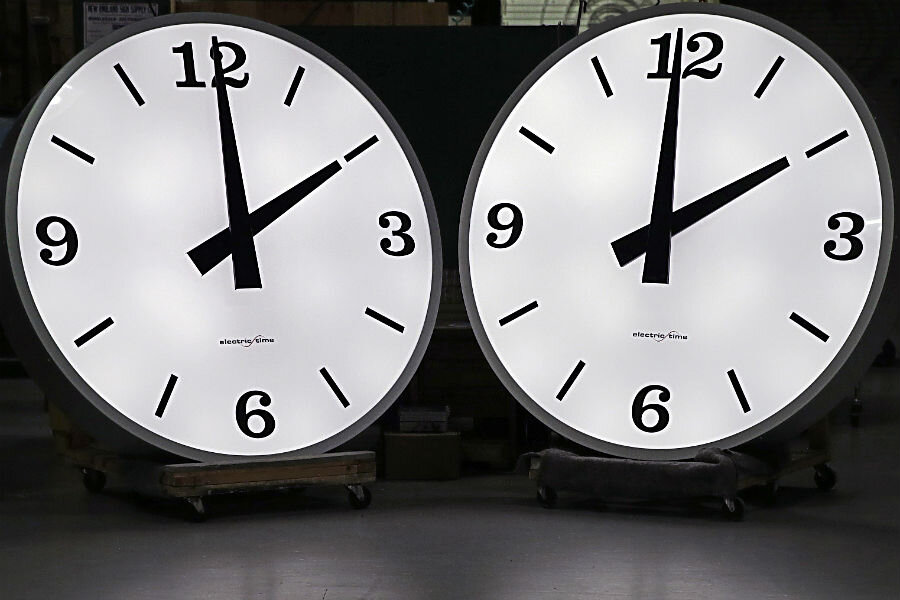Why do we still have daylight saving time?
Loading...
In 1784, Benjamin Franklin wrote a letter published in the Journal of Paris, in which he claimed he was perplexed that the sunrise preceded his own waking time at 6 a.m. If he – and everyone else – rose alongside the sun and went to bed earlier, they would be able to conserve hours of expensive candle use.
If the argument for daylight saving was rooted in economics back then, it’s still the case now. The contentious subject in its modern form dates back to the early 20th century, when Germany set its clocks one hour forward in order to conserve energy in the costs of World War I. The US and the rest of Europe followed suit.
But today, economics still applies. Depending on the latitude, a person living in a region that observes daylight saving (remember, no “s”) could see up to 200 more hours of sunlight a year. And what do people do when the sun’s out? Spend money.
“It feels like more daylight, because there’s daylight in the evening when people can use it rather than in the morning when most people sleep through it and they don’t see it at all,” David Prerau, author of “Seize the Daylight,” told Vice.
The petroleum industry, for instance, is a proponent of the clock-adjusting practice. The Association for Convenience and Fuel Retailing, a group that lobbies for convenience stores, has urged lawmakers to start daylight saving time even earlier. As of 2005, most of the US – every state except for Arizona and Hawaii – is in daylight saving mode for eight months of the year.
“Americans really do leave their homes when there is more sunlight at the end of the day,” Michael Downing, a lecturer at Tufts University and the author of “Spring Forward: The Annual Madness of Daylight Saving Time,” told The New York Times.
“We go to the parks, and we go to the mall, but we don’t walk there,” he said. “Daylight saving increases gasoline consumption.”
But daylight, supporters say, is beneficial even without the economic advantages. According to one study, the time change results in a lower crime rate because light discourages criminals from misdeeds that could be more easily witnessed.
To others, however, the tradeoff is not even. The opponents of daylight saving argue that the practice barely saves energy and has a number of negative health implications instead.
"Daylight saving was created to save energy, and it doesn't really do that," James Proud, an entrepreneur based in San Francisco, told the Huffington Post. "But what's even worse are its negative health effects. It's both antiquated and harmful."
While the schedule shift has been linked to a variety of ailments, daylight saving has the most profound effects on sleep. The average worker loses about 40 minutes of sleep when clocks are turned forward.
German scientists last year suggested that our circadian rhythms, or body clocks, never really recover from that adjustment.
"The majority of the population has drastically decreased productivity, decreased quality of life, increasing susceptibility to illness, and is just plain tired,” Till Roenneberg, a chronobiologist at Ludwig-Maximilians University in Munich, told National Geographic.
It’s been documented that in the week after DST, there’s a 17 percent increase in traffic accidents and a 3 percent spike in workplace accidents, and people are subsequently more than twice as likely to miss work.
Sheila Danzig, a Florida native, joins Mr. Proud in efforts to abolish daylight saving. For 20 years, she’s been advocating for the cause through her website, StandardTime.com. In this time, more than 82,000 people have signed her petition to Congress.
But some opposition to DST isn’t an objection to DST itself – it’s the inconsistent time frame of adhering to daylight saving for eight months of the year and standard time for four.
"About 70 percent [of the petition signers] wants permanent daylight saving time, and 30 percent think we should stick to standard time all year round," Ms. Danzig told the Huffington Post.
Joseph Stromberg, of Vox, makes the case for year round DST:
...[A] year-round DST would also be nice for anyone who works inside and simply likes to occasionally see the sun during the short days of winter. It'd mean getting up when it's a bit darker out in exchange for an extra hour of light after work. In Washington, DC, for instance, sunsets in the dead of winter would be at roughly 6 pm, instead of 5, and sunrises would be at 8:30 am instead of 7:30.
The extra hour of morning darkness would be a sacrifice. But the extra hour of evening light would be a bigger benefit to all of us for the same reason that manufacturers like it: we're much less likely to spend it inside, where we have artificial light either way.”






